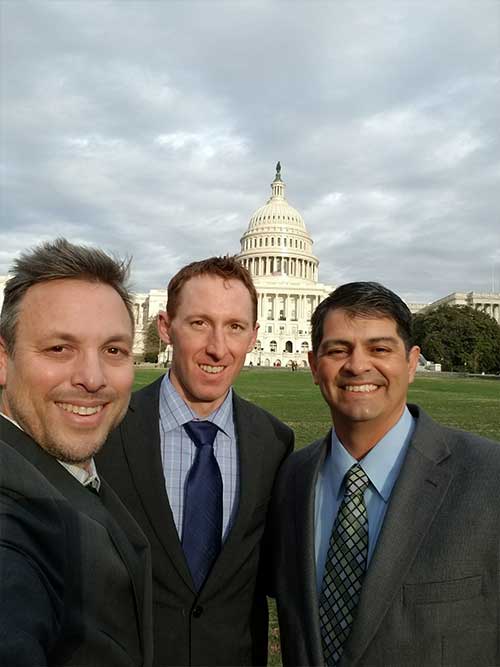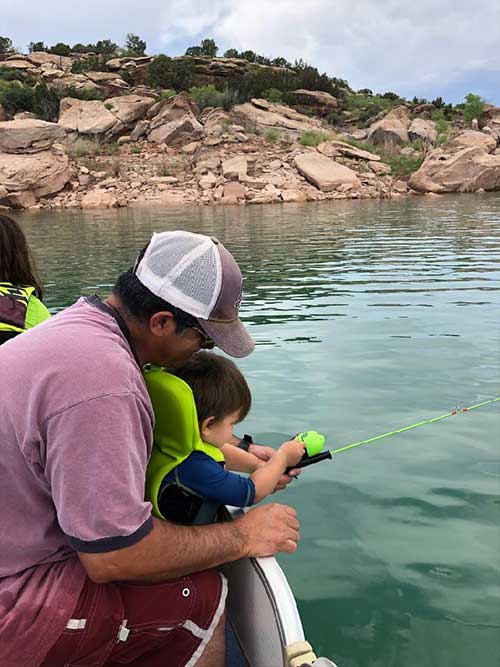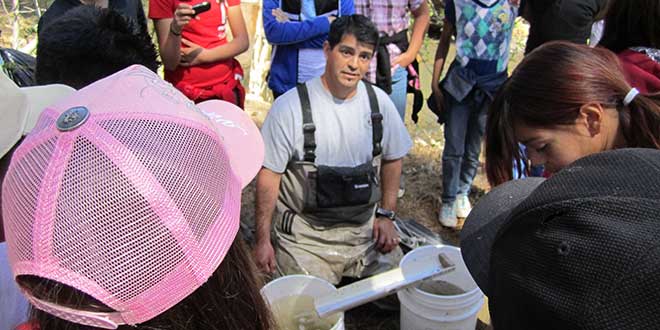Microscopic species are big business in New Mexico. The Department is concerned with several Aquatic Invasive Species (AIS). They are very small in size, but can reproduce quickly and cause significant harm to the natural environment should they enter New Mexico’s water bodies. New Mexico remains one of seven states in the west without a population of invasive zebra or quagga mussels.
The effort to keep these species out of New Mexico fall on a lot of people, both within the Department and from the public. However, the efforts are headed by James Dominguez. James has worked with the New Mexico Department of Game and Fish for over 15 years now. He is responsible for providing education and outreach, early detection monitoring and running a prevention program in order to reduce the threat of Aquatic Invasive Species introduction.


Recently, you may have heard about an aquatic moss ball, popular in personal aquariums, that contain an invasive mussel, the zebra mussel. James jumped to action, working with his collogues at the New Mexico Department of Game and Fish, the US Fish and Wildlife Service and several other state agencies to identify entry points for these products, working with local aquarium shops to remove the moss balls from the shelves and to provide education for the general public to understand the potential impacts if these items are not properly destroyed.
After 9 years working in the aquatic sciences for the state of Colorado, I saw a job posting for a full-time fisheries technician with the New Mexico Department of Game and Fish. I saw it as an opportunity to return to my home state to work with fish. For several years I worked as the fisheries management technician, followed by a few years as the Rio Grande cutthroat trout technician. When the Aquatic Invasive Species Coordinator position became available, I saw it as an opportunity to continue within conversation sciences and protect New Mexico waterbodies from invasive species. I grew up boating on Conchas Reservoir, so protecting our waterbodies is near and dear to my heart. ?What is the most exciting part of your job?
Any project that includes kids. Whether it is a fishing clinic or taking high school or college students out to help on a project, I enjoy seeing their faces as they hold a fish or are getting experience in our profession. I hope that they are the next fish biologists, that will replace me and my colleagues. ?What is your favorite part of working for the Department?
The variety! Some days I am in the field and some days I am in the office. Some days I am working with biologists or at a hatchery, some days I am working with other agencies in other states and most times I am working directly with the public. I enjoy meeting people, especially New Mexicans that are enjoying the outdoors. ?What are your hobbies, or what do you do when you are not at work?
Great question! I used to spend a lot of time mountain biking, whitewater rafting, fishing, snowboarding and participating in sports. With three young boys, my hobbies now include fishing and boating with my wife and kids, camping with my wife and kids and coaching my kids in soccer, baseball and basketball. I am active as a board member with American Youth Soccer Organization (AYSO), Little League and the local basketball league. ?What are some of the projects you will work on over the next year or several years?
I will continue to try and expand our prevention program to cover additional waters bodies in the state by engaging additional agencies and non-government entities. I would also like to start a citizen science program in which the public can report and enter potential invasive species finds. ?What else do you want the public to know about you or your job?
The threat of invasive species will be a continuing challenge. The task for the Department and the State of New Mexico is too big for any one agency. In order to keep aquatic invasive species in check and to prevent introduction, the public must participate by following protocols and being stewards for New Mexico outdoor resources. ?What is the most common question you get about your job, and how do you answer it?
Well it used to be, “Where can I catch the biggest trout or walleye?” I would answer, “Go to Conchas or Sumner Reservoir. People always catch fish there.” Nowadays, it is “Do we have zebra or quagga mussels in our state?” My answer is, “No we do not have them in New Mexico. We are 1 of 7 states in the west that does not, but the threat from boaters visiting from out of state is a big threat. If you have a boat, please Clean, Drain and Dry.” ?If someone is looking to get a career with Game and Fish in the future, what advice would you give them?
Volunteer and work harder than anyone else! When I completed college, I didn’t have a lick of experience in the aquatic sciences. Luckily, I had a few biologists that took a chance and allowed me to come help out. I didn’t know how to measure a fish, electro fish or repair a boat motor (still can’t fix a boat), but I knew how to carry gear and be the last one working at the end of the day. Before long, I had the experience and those same biologists were now counting on me to be a part of the sampling crew. It wasn’t long that I had plenty of experience and I could compete for open fishery positions.
 New Mexico Wildlife magazine Conserving New Mexico's Wildlife for Future Generations
New Mexico Wildlife magazine Conserving New Mexico's Wildlife for Future Generations
